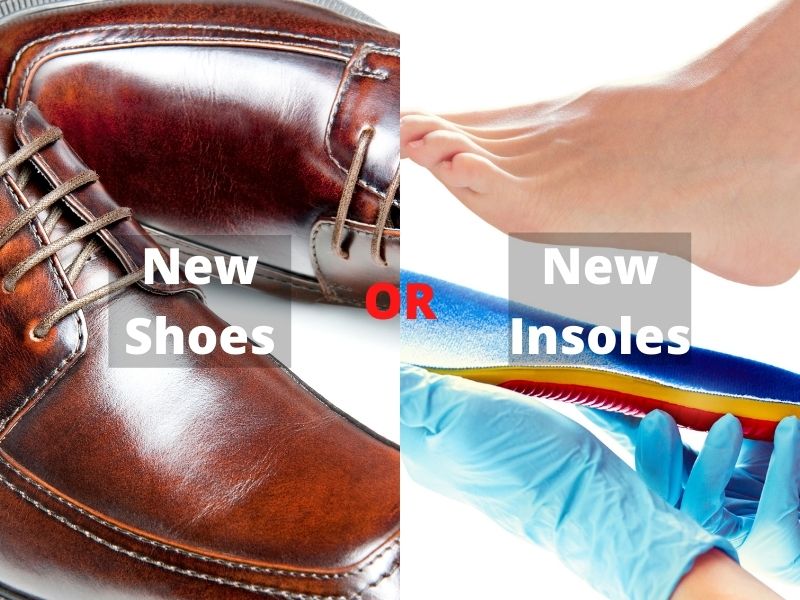Deciding to toss out your worn out, favorite pair of shoes may be as easy as buying a new pair. However, that is not always the case, especially when there is a solution like replacing insoles to give your old trustees an extended life. But how can one possibly decide which is more reasonable?
Get new shoes or replace insoles? How to decide? All things wear out eventually over time, including shoes and their insoles. Replacing insoles is only a temporary solution for extending the life of your worn-out support, but that is not the purpose of insoles. A new pair of shoes may be required.
When deciding to buy new shoes or to replace the insoles, some factors like determining how worn out the overall shoe plays an important part in the matter. If the shoes are really soft and flexible, insoles may not help, and you will need to buy new shoes.
How to Determine if Shoes Need Replaced
When deciding whether to get new shoes or just replace the insole, a good place to start is knowing when it is time to retire your current shoes. Signs of wear include:
- Midsole Wrinkles: Flip the shoe over and examine for wrinkles on the base of the shoe. Once this area that absorbs the shock is worn, it is a sure sign they need replaced.
- Forefoot Wear and Heel Wear: These areas wear around the edges of the shoes because of how you walk. If these show wear, it is a good sign they need replaced.
- Outsole Wear: Bottom of the shoe is completely worn. When on a flat surface, if the shoe rocks and tips because the bottom is no longer level.
- 500 Mile Marker: Most shoes last anywhere from 300 to 500 miles, whether that is running or walking miles. Shoes will begin to wear in between this mile range.
In most cases, shoes usually last between 8-12 months of wear for running shoes. However, everyone’s foot is different, so it is suggested to inspect your shoes for wear around the 6-month marker.
Listen to Your Body

Another way you can tell if your shoes need replacing is if your body is starting to ache from walking or even running. If you are feeling pain in your hips, knees, or back it could be a sign your shoes are the stem of the problem.
Now it is time to decide if an insole will help this pain or if it is time to buy a new pair of shoes.
I can tell you if the shoe has the type of wear such as the midsole wrinkles, forefoot, and heel wear, and you’ve reached max mile capacity it is time to purchase a new pair of shoes. The reason being is that a shoe with this kind of wear will not extend its life with an insole. The purpose of an insole is not to extend the over-life expectancy of the shoe.
Purpose of Insoles
It’s vital to keep in my mind what the role of an insole really is. Insoles are to help with support for your foot and help with body alignment. While they may give a little more life to a slightly worn-out shoe, that isn’t really their job.
Although the foundation of the sole is the insole, if the shoe the insole is going in is too soft and worn, it could compromise the insole. This insole needs a solid foundation to function properly and do its job completely. The general rule is that when the foam of the insert is compressed, it is time to replace the insole inside the shoe. Compressed foam can cause discomfort, and that is when you might start to notice body pain associated with the insole when walking.
The shock that the foam used to absorb is now being transferred to your body instead of the insole since it is worn down. This is when you will notice it is time to replace your insole if the shoe is in decent shape still.
Since every foot is different, an insole’s life expectancy may differ. Typically, insoles should be changed every 12 months. This can be extended longer if the wear is less than average.
Once you’re ready to get new insoles it’s easy to measure and cut them to size. See video for example.
Guide to Purchasing New Shoes
There are guides for buying new shoes to maximize the benefits the shoe will provide to your foot.
- Measure your feet professionally: recommended every time you buy new shoes as each foot is different.
- Wait until the afternoon: some feet swell during warmer weather and expand naturally during the day.
- Walk around in the shoes: question the comfort level of the shoe while walking in them. Do they support your feet or feel like they need stretching. Find a shoe that fits immediately. Do not rationalize it will fit over time.
- Stand still in the shoes: Space between the longest toe and end of the shoe should be one-quarter inch to half an inch.
- Examine the soles: Are they supported with cushion to support shock absorption.
When in doubt, purchasing new shoes to replace old ones, once replacing the insole is out of the question, seek advice from a shoe salesperson to find shoes right for your feet. It is such a sad feeling to replace your favorite pair of shoes and cannot find a replica, but getting professional help may be worth it.
Guide to Proper Insoles
In most cases, shoes are designed with minimum support that fits the vast majority of people. This is where insoles are a better option than replacing new shoes you just bought for a better, more comfortable pair.
Over-the-counter insoles work just fine for most people. Although, if you have special needs for your feet due to health conditions a podiatrist can special order insoles specifically for your feet.
The most common full-length, over-the-center insoles include arch-supporting insoles, cushioned insoles, and heat-moldable insoles.
- Arch-supporting insoles: provide comfort and prevent injury.
- Cushioned insoles: are made with foam and gel to cushion each step. These are typically one-size fit all and have little arch support.
- Heat moldable insoles: can be heated and molded to your foot. Not ideal for the long term.
A key component to keep in mind when seeking which insole is best for you is that if you can press down on the arch, that means it is not stable enough.
If your shoe is causing you pain, it would be wise to try replacing the insole with something that offers more support. Just be sure that the shoe you’re replacing an insole in is not completely worn and is stable enough to provide a solid foundation.
There are many brands of insoles to choose from. Some highly ranked brands are listed in the link below.
|
$39.99
|
$10.99
|
$18.99 ($18.99 / Count)
|
How to Decide
Ultimately, if the shoe shows wear more than 500 miles and are soft and fragile, an insole will not fix the issue. This is when buying new shoes is required. Alternatively, if the shoe is relatively new and still has a solid foundation, but causing you joint pain in the knees and hips, replacing the insole would be a wise option initially prior to buying new shoes.
After all, some shoes can be expensive but may be worth the extra cost if they will last 8 to 12 months and hold their comfort with the addition of a new insole.
Thanks for visiting Helpshoe.com
References
https://www.health.harvard.edu/pain/8-tips-for-buying-shoes-that-are-good-to-your-feet
https://treadlabs.com/blogs/insoles-reach-your-stride/shoe-inserts-a-beginners-guide




